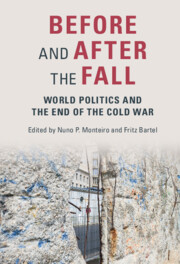Book contents
- Before and After the Fall
- Before and After the Fall
- Copyright page
- Dedication
- Epigraph
- Contents
- Figures
- Tables
- Contributors
- Preface
- Introduction
- Part I Sources of Continuity and Change
- 1 Overcoming Stagnation
- 2 Mikhail Gorbachev
- 3 Peace Through Strength and Quiet Diplomacy
- 4 “Keeping Them Well Behind”
- 5 Only One Way Forward
- Part II Continuity and Change Across the 1989/1991 Divide
- Part III Toward a New World Order?
- Index
2 - Mikhail Gorbachev
The Anatomy of New Thinking
from Part I - Sources of Continuity and Change
Published online by Cambridge University Press: 02 December 2021
- Before and After the Fall
- Before and After the Fall
- Copyright page
- Dedication
- Epigraph
- Contents
- Figures
- Tables
- Contributors
- Preface
- Introduction
- Part I Sources of Continuity and Change
- 1 Overcoming Stagnation
- 2 Mikhail Gorbachev
- 3 Peace Through Strength and Quiet Diplomacy
- 4 “Keeping Them Well Behind”
- 5 Only One Way Forward
- Part II Continuity and Change Across the 1989/1991 Divide
- Part III Toward a New World Order?
- Index
Summary
This chapter recounts Mikhail Gorbachev’s vision for the post-Cold War world order, focusing in particular on the disarmament negotiations and the Soviet withdrawal from Afghanistan. The chapter argues that Gorbachev’s foreign policy was underpinned by the ambition to recapture moral leadership in the world (which, for the Soviet leader, was closely linked to the legitimacy of the Soviet project, and indeed to his own political legitimacy). This ambition was clearly discernible in his approach to disarmament. The vision of a nuclear-free world (as presented by the General Secretary in 1986) was instrumental to the broader agenda of global leadership, which, Gorbachev felt, the Soviet Union had long abandoned. The same agenda animated his approach to the war in Afghanistan: Leaving Afghanistan was important for moral reasons, as a practical manifestation of the new spirit Gorbachev purported to represent. The exit was delayed, however, when the Soviet leader realized that quitting the war carried its own implications for Moscow’s global standing, and, in particular, undercut Soviet credibility in the third world. By recentering the Cold War endgame on Gorbachev’s global ambitions, the paper seeks to contextualize the General Secretary’s approach to foreign policy within the broader tradition of Soviet political leadership during and after the Cold War.
- Type
- Chapter
- Information
- Before and After the FallWorld Politics and the End of the Cold War, pp. 45 - 61Publisher: Cambridge University PressPrint publication year: 2021



